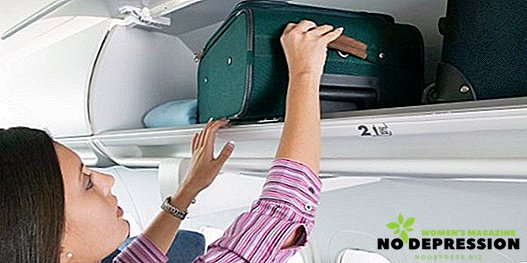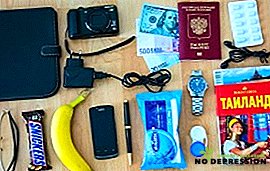Airplanes have long been incorporated into the daily lives of many people, be it domestic flights at work or overseas flights to rest. Convenience and speed of travel, however, may be overshadowed by unforeseen situations involving luggage.
In order to avoid many misunderstandings, it is worthwhile to familiarize yourself with the rules of bringing carry-on baggage on board the aircraft.

Carry-on baggage: allowable size and weight
To begin with, I would like to say a few words about what hand luggage is. This term refers to backpacks, handbags, bags, small travel bags, compact suitcases and other small-sized tanks for the transport of items and items of daily use permitted on board.
Outerwear, whether voluminous jackets or coats, is not included.
Each airline has its own specific numbers that determine the size of hand luggage on the plane, allowed on board. These numbers are determined by the safety and size of the place, laid down in the cabin under the personal belongings of passengers.
The height, width and length of bags can vary between 10–15 cm, but in general, most air carriers converge on the total number of all measurements, equal to about 115 cm. With the maximum possible weight, everything is also rather ambiguous. Approximate possible limits of mass fluctuate around 8-13 kg.
Compliance with the size and weight of carry-on baggage is mandatory, especially if it is really important for a passenger to take certain things on board. Otherwise, things that exceed the permissible size and weight parameters will have to be handed over to the luggage compartment or improvised, laid out in a smaller container, which is very unpleasant.
To make sure that things fit in size and weight, you can use weights and special measuring forms located at airports.
It should be noted that hand luggage may consist of one or two or three bags, if these bags satisfy the overall dimensions and do not exceed the weight allowed on board. The number of pieces of luggage, as a rule, depends on the class and the airline.
Low-cost airlines usually provide one seat, in more well-known companies more often two seats are provided. The same can be said about the different conditions of baggage transportation in economy and first class.
Also in some airlines there is a division of baggage in size. Large carry-on luggage charges may apply.
List of things allowed on board
Carry on board the aircraft, you can only the most necessary. The list of things that can be in hand luggage includes:
- Drinking fluids such as water, juices and other soft drinks in the closed state up to 100 ml. Drinks from the Duty Free Airport are also allowed, subject to the integrity of the container, it is better to keep the purchase receipt, because inspectors may ask for it;
- Not drinking liquids, which include decorative cosmetics and skin and body care products. This category of objects by volume should not exceed 1 liter and should be packed in a resealable plastic transparent bag, each unit of the category should be no more than 100 ml in volume;

- Medications, some of which are permissible only if there is a document from the doctor, which confirms the need to bring them on board;
- Equipment for personal use, such as a tablet, phone, camera or laptop and other similar small-sized technical accessories. Some of these devices cannot be used during the flight, which does not exclude the possibility of taking them on board;
- Clothing. It can be quite cool after taking off on board, so bringing a coat, jacket or sweater into the cabin is not reproached;
- Small bags for personal items or equipment. Ladies' bag, laptop or camera bag and the like, are included in the list of things allowed on board;
- Books, magazines and other printed materials;
- Food. Officially, food can be taken on board the aircraft, so that fruit, pastries and sandwiches can easily be placed in the passenger's carry-on baggage. But there are also some limitations;
- Valuables such as jewelry, apartment keys, etc .;
- Documents and money.
Why not put in a suitcase
Some things aboard the aircraft there is a strict ban:
- Alcohol and detergents, such as gels, shampoos, and so on;
- Toxic, radioactive, combustible substances and liquids, including household chemicals and perfume;
- Stabbing and cutting objects, including knives, scissors, screwdrivers and other construction equipment, manicure accessories, razors, cutlery and other metal objects;
- Weapons and ammunition, whether they are real combat models or imitations and children's toys in the form of pistols and so on; gas sprays and other means of self-defense are also prohibited on board;
- Any liquid in excess of 100 ml in volume, with the exception of drugs and baby food;
- Magnetic materials.
In addition, some air carriers have some additional prohibited items, a list of which is better read in advance.
The rules of transportation of things
Even the right set of things needs special packaging. For example, non-drinking liquids are packaged in a transparent resealable plastic bag of 20 * 20 cm, such a bag can be only one, the volumes of liquids are indicated above.
Exceptions are medicines and baby food, if the passenger flies with the child. Despite the fact that food can be taken on board, it is worth noting that there may be restrictions on the transportation of meat and dairy products on international flights.
Tips to save space
Placing hand luggage in the cabin can be varied, I would like to consider one of the options. Small-sized bags are best removed on the top shelves, large bags would be most sensible to put next to the seat or put under it.
Putting bags in the aisles, in the tail of the aircraft or in the service premises is prohibited. Items for personal use, ladies' bag, food and drinks, medicines and books can be put next to you or on a special passenger table.
Baggage allowance
As a rule, the cost of baggage is included in the ticket price. This does not apply to low-cost airlines that sell economy tickets. These companies include only hand luggage in the ticket price.
Oversized carry-on luggage may also need an extra surcharge.
As a rule, most airlines offer free baggage allowance weighing up to 10-15 kg and hand luggage weighing 8-10 kg. Anything that exceeds the specified mass requires additional payment.
Additional information about hand baggage is in the next video.













